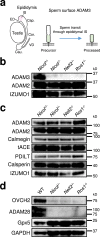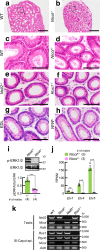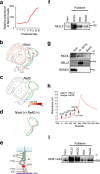A small secreted protein NICOL regulates lumicrine-mediated sperm maturation and male fertility
- PMID: 37095084
- PMCID: PMC10125973
- DOI: 10.1038/s41467-023-37984-x
A small secreted protein NICOL regulates lumicrine-mediated sperm maturation and male fertility
Abstract
The mammalian spermatozoa produced in the testis require functional maturation in the epididymis for their full competence. Epididymal sperm maturation is regulated by lumicrine signalling pathways in which testis-derived secreted signals relocate to the epididymis lumen and promote functional differentiation. However, the detailed mechanisms of lumicrine regulation are unclear. Herein, we demonstrate that a small secreted protein, NELL2-interacting cofactor for lumicrine signalling (NICOL), plays a crucial role in lumicrine signalling in mice. NICOL is expressed in male reproductive organs, including the testis, and forms a complex with the testis-secreted protein NELL2, which is transported transluminally from the testis to the epididymis. Males lacking Nicol are sterile due to impaired NELL2-mediated lumicrine signalling, leading to defective epididymal differentiation and deficient sperm maturation but can be restored by NICOL expression in testicular germ cells. Our results demonstrate how lumicrine signalling regulates epididymal function for successful sperm maturation and male fertility.
© 2023. The Author(s).
Conflict of interest statement
The authors declare no competing interests.
Figures







Similar articles
-
Lumicrine signaling: Extracellular regulation of sperm maturation in the male reproductive tract lumen.Genes Cells. 2023 Nov;28(11):757-763. doi: 10.1111/gtc.13066. Epub 2023 Sep 11. Genes Cells. 2023. PMID: 37696504 Free PMC article. Review.
-
Expression of NELL2/NICOL-ROS1 lumicrine signaling-related molecules in the human male reproductive tract.Reprod Biol Endocrinol. 2024 Jan 2;22(1):3. doi: 10.1186/s12958-023-01175-6. Reprod Biol Endocrinol. 2024. PMID: 38169386 Free PMC article.
-
The molecular mechanisms of mammalian sperm maturation regulated by NELL2-ROS1 lumicrine signaling.J Biochem. 2022 Dec 5;172(6):341-346. doi: 10.1093/jb/mvac071. J Biochem. 2022. PMID: 36071564 Review.
-
NELL2-mediated lumicrine signaling through OVCH2 is required for male fertility.Science. 2020 Jun 5;368(6495):1132-1135. doi: 10.1126/science.aay5134. Science. 2020. PMID: 32499443 Free PMC article.
-
Adhesion G protein-coupled receptor G2 is dispensable for lumicrine signaling regulating epididymal initial segment differentiation and gene expression†.Biol Reprod. 2023 Oct 13;109(4):474-481. doi: 10.1093/biolre/ioad087. Biol Reprod. 2023. PMID: 37531264 Free PMC article.
Cited by
-
Gene-deficient mouse model established by CRISPR/Cas9 system reveals 15 reproductive organ-enriched genes dispensable for male fertility.Front Cell Dev Biol. 2024 May 21;12:1411162. doi: 10.3389/fcell.2024.1411162. eCollection 2024. Front Cell Dev Biol. 2024. PMID: 38835510 Free PMC article.
-
Structures and pH-dependent dimerization of the sevenless receptor tyrosine kinase.Mol Cell. 2024 Dec 5;84(23):4677-4690.e6. doi: 10.1016/j.molcel.2024.10.017. Epub 2024 Nov 6. Mol Cell. 2024. PMID: 39510067
-
Mapping cis- and trans-regulatory target genes of human-specific deletions.bioRxiv [Preprint]. 2024 Dec 1:2023.12.27.573461. doi: 10.1101/2023.12.27.573461. bioRxiv. 2024. PMID: 38234800 Free PMC article. Preprint.
-
Lumicrine signaling: Extracellular regulation of sperm maturation in the male reproductive tract lumen.Genes Cells. 2023 Nov;28(11):757-763. doi: 10.1111/gtc.13066. Epub 2023 Sep 11. Genes Cells. 2023. PMID: 37696504 Free PMC article. Review.
-
Chemical Synthesis of NICOL, A Coligand Secreted Protein Mediating Mammalian Male Reproductive Tract Trans-luminal Signaling.Chemistry. 2025 Aug 21;31(47):e01588. doi: 10.1002/chem.202501588. Epub 2025 Jul 26. Chemistry. 2025. PMID: 40713872 Free PMC article.
References
-
- Greep RO, Fevold HL. The spermatogenic and secretory function of the gonads of hypophysectomized adult rats treated with pituitary FSH and LH. Endocrinology. 1937;21:611–618. doi: 10.1210/endo-21-5-611. - DOI
Publication types
MeSH terms
Grants and funding
LinkOut - more resources
Full Text Sources
Molecular Biology Databases

